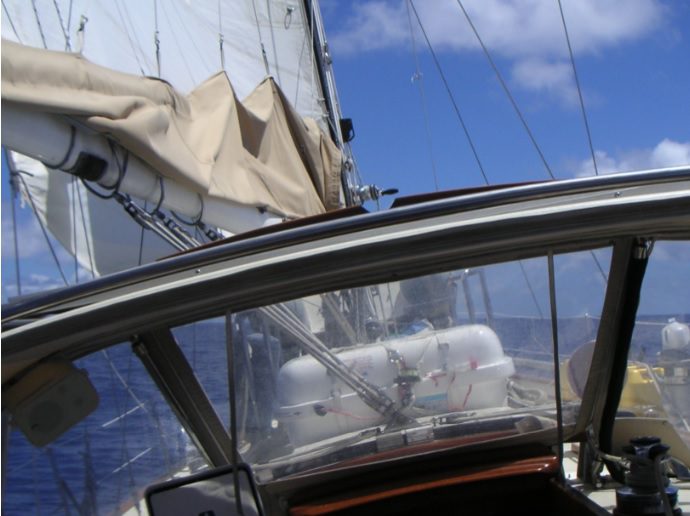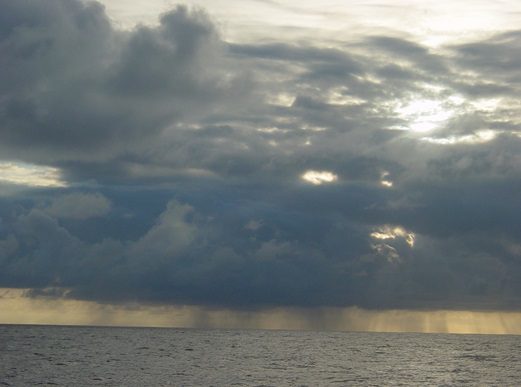A Typical Day at Sea
Hello friends and family,
Wednesday April 21 .. lunch time ….We’re currently at S 06 deg 41 min / W 110 deg 51 min.
Journal entry from Yesterday:
Tuesday, April 20, 2004:
S 06o22′
W 108o45′
(Day 8 at sea: 1171 nautical miles from the Galapagos Islands, 1795 from
the Marquesas)
On Dick’s advice, we have adopted the Navy’s traditional watch schedule of four hours on, eight off, interrupted by a pair of two-hour watches between Midnight and 4:00 am. The latter, called dogging the watch, serves two purposes. It shortens the watch time required during the early hours of the morning, when staying alert can be a battle. It also provides variety in the schedule by shifting an individual’s watch times from one day to the next.

Last Sunday I had the eight to midnight shift. The winds were light, 10-15 knots, out of the southeast, much as they have been for the last week. There was sufficient roll in the seas to make it difficult to keep our mainsail and genoa filled without their flapping and banging as the boat rolled from side to side. We had recently discovered that a much quieter and efficient alternative is to fly the spinnaker. For those unfamiliar with sail terminology, a spinnaker is one of those large balloon-like sail that puffs up in front of the boat much like the bellows of the Frigate birds back in the Galapagos. The sails are typically very colorful and often featured in photographs of sailboat races. On board the Lillian B., flying the spinnaker was a relatively new experience for us. The advantage of the spinnaker in relatively gentle winds and rolling seas is that it is light and large enough to stay airborne, instead of collapsing as do the heavier main sail and jibs. With only the spinnaker, Lillian was able to maintain a respectable five to six knots without the jar and bang of the other sails jerking on their restraining lines. With “Hal” the autopilot steering the boat, it was turning out to be a peaceful watch, requiring only the occasional push of a button for a slight course correction. The night was typical, with starlight from overhead and a haze of humidity on the horizon. However, as also seems to be typical, something would happen to stir things up.
On this particular watch, the disturbance was a brilliant white light illuminating the cockpit. My first thought was that it was one of our two “high tech” LED Streamlight Flashlights. After little more than a month at sea, both of these units have acquired the annoying habit of flashing on when not expected and not turning on when you needed them the most. But, even as I turned, I realized the light was too bright to be a flashlight and besides, it was clearly coming from astern. I looked back in time to see the fading of a single burst white flare streaking upward, similar to the hand held flares common on the Fourth of July. The distance was difficult to judge. The next instant it was dark, with no other boat in sight.
My first action was to call out that I’d just seen a flare. Peter and Dick were sleeping below. Peter, being closest, heard me first and was on deck within less than a minute. On the way up, he pressed the MOB (Man-Over-Board) button on the Global Positioning System (GPS), to mark the position. Dick was not far behind, and after a brief discussion he went back below to turn on the SSB radios and listen for any distress calls.
As we would reconfirm the next day in one of our nautical references, a white flare is to be used for collision avoidance, as opposed to a red flare, which signals distress. None-the-less, for the next few hours we treated the sighting as a potential distress call. The first course of action was to “douse” the spinnaker so we could head back upwind to the spot of the signal. This turned out to be a much more difficult task than we’d anticipated. Peter went forward to haul down the sleeve that shrouds and deflates the sail. In the daytime, this had worked smoothly but with the darkness and stronger winds, the shroud lines were wrapping and jamming. It took us over twenty minutes to secure the spinnaker with me steering the boat and Peter working hard in the dark while being flailed by the lines up forward. Meanwhile, Dick was attempting to hail the other boat via VHF radio and checking for their echo on radar. Both efforts were met with no luck. Whoever they were, the originators of that flare weren’t big enough to reflect radar, and they had no radio communication. (This would be consistent with their use of a flare as a collision avoidance signaling device.) Finally, with the spinnaker secured, we motored back against the waves to the MOB point entered earlier.
Once at those coordinates, we shut off the engine and watched and listened. We also noted the velocity of our drift to estimate where a lifeboat would have gone in the time it had taken us to return to the original spot. The current has been relatively strong since the Galapagos, at 1.5 to 2 knots to the NW and, combined with the wind, would carry a boat a significant distance. We figured that someone at sea level would be able to see our masthead light at a distance of 3 to 6 miles. After waiting and watching for over half an hour, we decide to proceed in the direction of the current before returning to our course. In the hopefully unlikely event that the signal had come from a life raft, this would allow us to catch up with them. By this time it was 0200. Peter’s scheduled midnight to 0200 watch had passed as an “all-hands-on-deck” exercise. The next watch, 0200-0400, belonged to Dick, but Peter stayed on deck to help with sail changes and keeping a look-out, while I went below to catch a couple hours of sleep before my impending 0400-0800 morning watch.
As expected, 0400 came quickly, but coffee and the promise of daybreak made it not as bad a watch as one might expect. In fact, normally, the 0400-0800 time is a favorite watch with its magical transition from night to morning. Sunrise is at first barely perceptible as a subtle lightening of the eastern horizon. It is difficult to conceive that the vast ocean through which we are plodding westward at 5 to 7 knots is actually spinning eastward towards the sun at nearly 1000 miles per hour. That morning, however, I was too preoccupied with the events of the night before to appreciate sunrise. There had been no further sightings during Dick’s watch and we were back on course for the Marquesas. After Peter appeared on deck for the 0800-1200 watch with his characteristic mussed hair and cheerful, “Good Morn’n Capt’n!” we soberly concurred that we needed to improve on our emergency response skills, from taking down sails to man-over board drills.
I had been thinking of a drill later in the day, but, not being one to procrastinate, Peter emerged from below within a minute or two with a cardboard box which he immediately threw over-board with the loud cry of “Man-over-board.” Poor Dick says that he awoke from his deep slumber not knowing what the hell was going on. In a daze, and mussed hair that surpassed Peter’s, Dick struggled on deck to find me at the helm, Peter spectating, and an empty family-sized box of oatmeal falling fast astern. During the first hour of Peter’s morning watch, we did three man-overboard drills in succession, each one of us taking a turn at the helm. Our skill improve each time, although, alas, for the third drill the box never made it back on board, not having a life jacket and not being a very good swimmer. We watch sadly as it sank under the waves.
After the drills, we re-rigged the spinnaker, practiced a round of raising and lowering, and set it for the day. Dick then headed down for some well deserved rest before his 1200-1600 watch and I performed the house keeping chores that have been assigned as part of the 0400-0800 watch. These tasks include checking the engine, charging the batteries, cooling the refrigerator via an engine driven compressor, and running the watermaker to extract fresh drinking water from the salty sea. After that, I was free until my next watch, the dinner shift, from 4pm to 8pm. I mostly slept.
The preparation of dinner on a given day is the responsibility of the crew who stands the afternoon watch from noon to 4:00pm. On this day, that was Dick, who before he ever set foot on board Lillian, warned us that we didn’t want him anywhere near the galley. While past experience lends some credence to this warning, the watch schedule tolerates no exceptions. Actually, Dick is becoming an accomplished chef despite himself. As you might imagine, eating is an important event at sea. It is a moral booster for both the cook and the consumer to have a meal that doesn’t look as if it came out of a can. On this day, Dick prepared clams and linguine with home made bread (baked by Peter the day before), peaches, and green beans on the side. With a little Chilean white wine from a small market in the Galapagos, it was a complete success.
As Dick served us dinner, it was my turn to sit in the helmsman chair, making sure Hal kept a good course. During the 4pm to 8pm shift, the watchman typically has company on deck, with all three of us in the cockpit for dinner and sunset. Although none of us would probably be considered conversationalist, the evening watch is often spent watching night fall and discussing any range of topics. Occasionally there is a little rum or “gin and tonic” involved. That evening we talked mostly about the events of the day and night before. After a non-eventful watch, Peter relieved me, assuming the 8 to midnight time slot I had stood the night before. His watch, too, was uneventful.
While the flare sighting was unusual, the pattern of a set watch routine interrupted by unusual events has been more the norm than the exception over the last week. Some days have been sufficiently quiet to allow time to read and study, but usually something will occur to require all hands on deck. Sunday it was the flare, yesterday it was a 4:00 am rain squall that broke a halyard, dropping the spinnaker into the water. Last Saturday it was Peter’s catching our first fish. Such is our typical day.
